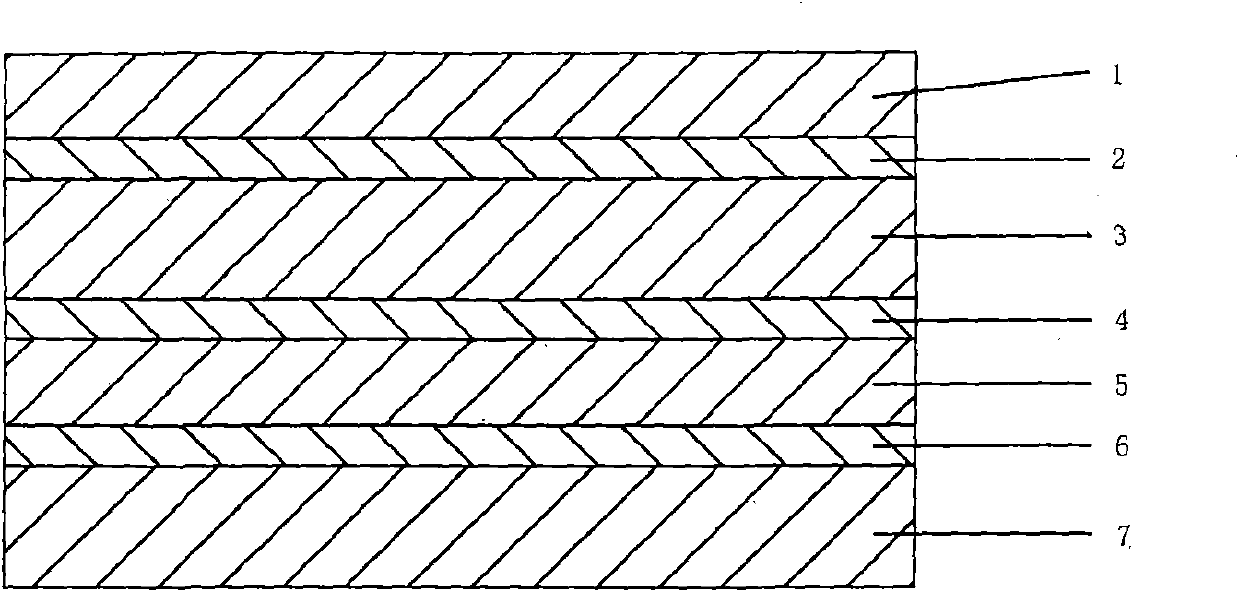Insulation backboard for solar photovoltaic module
A solar photovoltaic and component technology, applied in photovoltaic power generation, electrical components, semiconductor devices, etc., can solve problems that affect the service life of solar photovoltaic components, failure of insulating backplane protection performance, and accelerated decomposition of polyvinylidene fluoride. Low cost, meet the requirements of industrial scale-up production, and ensure the effect of service life
- Summary
- Abstract
- Description
- Claims
- Application Information
AI Technical Summary
Problems solved by technology
Method used
Image
Examples
Embodiment 1
[0024] please see figure 1 , the given insulating backsheet for solar photovoltaic modules includes a weather-resistant layer 1, a barrier layer 3, an electrical insulating layer 5 and an adhesive layer 7, and the surface of the barrier layer 3 facing the weather-resistant layer 1 is figure 1 The surface facing upwards is bonded together by the first adhesive layer 2 and the weather-resistant layer 1, and the side surface of the barrier layer 3 facing the electrical insulating layer 5 is figure 1 The surface facing downwards is shown by the second adhesive layer 4 and one side surface of the electrical insulating layer 5 ( figure 1 The side facing upward) is bonded as a whole, and the other side surface of the electrical insulating layer 5 is figure 1 The surface on the side facing downwards is shown, that is, the surface on the side facing the adhesive layer 7 is bonded together by the third adhesive layer 6 . In the state of use, that is, when the insulating backsheet for ...
Embodiment 2
[0028]Change the thickness of the weather-resistant layer 1 to 50 μm, change the thickness of the barrier layer 3 to 4 μm, change the thickness of the electrical insulation layer 5 to 250 μm, and change the thickness of the adhesive layer 7 to 50 μm. The parts by weight of vinyl fluoride, acrylic resin and inorganic material are respectively changed into 20 parts, 12 parts and 1 part, wherein: acrylic resin uses polybutylmethacrylate, and inorganic material uses carbon black; The materials of adhesive layers 2, 4 and the third adhesive layer 6 all use acrylic adhesive, and the barrier layer 3 is a polyethylene terephthalate film ( PET film), the material of the electrical insulation layer 5 uses polyethylene 2,6-naphthalate, and the material of the adhesive layer 7 is changed to low-density polyethylene. All the other are the same as the description to embodiment 1.
Embodiment 3
[0030] Change the thickness of the weather-resistant layer 1 to 30 μm, change the thickness of the barrier layer 3 to 20 μm, change the thickness of the electrical insulation layer 5 to 180 μm, and change the thickness of the adhesive layer 7 to 30 μm. The material of the electrical insulation layer 5 is poly Amide; Change the parts by weight of polyvinylidene fluoride, acrylic resin and inorganic material to constitute the weather-resistant layer 1 into 65 parts, 45 parts and 10 parts respectively, wherein: acrylic resin uses polybutylmethacrylate, adhesive The bonding layer 7 uses ethylene-vinyl acetate copolymer. All the other are the same as the description to embodiment 1.
PUM
| Property | Measurement | Unit |
|---|---|---|
| Thickness | aaaaa | aaaaa |
| Thickness | aaaaa | aaaaa |
| Thickness | aaaaa | aaaaa |
Abstract
Description
Claims
Application Information
 Login to View More
Login to View More - R&D
- Intellectual Property
- Life Sciences
- Materials
- Tech Scout
- Unparalleled Data Quality
- Higher Quality Content
- 60% Fewer Hallucinations
Browse by: Latest US Patents, China's latest patents, Technical Efficacy Thesaurus, Application Domain, Technology Topic, Popular Technical Reports.
© 2025 PatSnap. All rights reserved.Legal|Privacy policy|Modern Slavery Act Transparency Statement|Sitemap|About US| Contact US: help@patsnap.com



